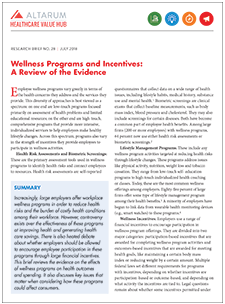Improving Value
Wellness Incentives
Employee wellness programs were created to address common health concerns and encourage the receipt of preventive care. Because these programs vary greatly depending on the health concerns they address and services they provide, this "approach" is best viewed as a spectrum. On one end of the spectrum are low-touch programs that focus primarily on assessment of health problems and provide limited educational resources. On the other end are high-touch, comprehensive programs that provide intensive, individualized services to help employees make healthy lifestyle changes. Examples of wellness program activities include: health risk assessments, biometric screenings, lifestyle management programs and wellness incentives.
Evidence is mixed with respect to the benefits of wellness programs. Some research has documented health benefits, such as decreased smoking rates and weight loss, while other studies have concluded that wellness programs have a negligible effect.1 Additionally, evidence suggests that wellness programs have failed to produce significant healthcare savings.2 Given the weak case for wellness programs, policymakers and employers should carefully reevaluate proposed wellness activities and the use of large incentives to push workers into participating into these programs.
Notes
1. Ossila, Karen Chan, et al., "Systematic Review of the Impact of Worksite Wellness Programs," American Journal of Managed Care, Vol. 18, No. 2 (February 2012).
2. Mattke, Soeren, et al., "Workplace Wellness Programs Study: Final Report," RAND Corporation, Santa Monica, CA (2013).
- New York Times: Workplace Wellness Programs Don't Work Well. Why Some Studies Show Otherwise (August 6, 2018).
- Preventative Medicine: Personal Financial Incentives for Changing Habitual Health-Related Behaviors: A Systemic Review and Meta-Analysis (April 2015).
- Kaiser Health News: Paying Medicaid Enrollees to Get Checkups, Quit Smoking and Lose Weight: Will It Pay Off? (May 4, 2015).
- American Journal of Managed Care: Systemic Review of the Impact of Worksite Wellness Programs (February 17, 2012).







